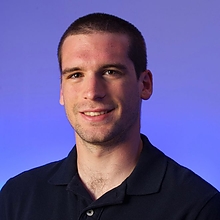 A graduate student in the Joint Center for Quantum Information and Computer Science (QuICS) is looking for novel ways to transmit quantum data across large distances.
A graduate student in the Joint Center for Quantum Information and Computer Science (QuICS) is looking for novel ways to transmit quantum data across large distances.
Andrew Glaudell, a third-year doctoral student in physics, says that while quantum information can be transported across short intervals in a lab environment, large-scale networks will be necessary in the future for quantum communication and computation.
But with these bigger networks come more complications, says Glaudell, who graduated from the University of Wisconsin with a bachelor’s degree in physics and engineering.
“In order to someday have a quantum network that connects distant parties, we need to be able to share quantum information from one location to another,” he says. “As of right now that’s very difficult to do because of information loss that occur in transit from point A to point B. Unfortunately, we can’t use the same tricks to overcome this as we can for classical information.”
In classical communication, signals are able to travel over long distances because repeaters amplify them at nodes interspersed along the way. Because quantum states can’t be noiselessly amplified, this is impossible in quantum communication, Glaudell says. To overcome that, researchers have devised devices called quantum repeaters.
These repeaters entangle stationary qubits at adjacent nodes using light. Using a procedure known as entanglement swapping, entanglement may be established between the qubits at the first and last nodes. However, these repeater protocols suffer from low entanglement rates due to the back and forth communication required to verify that entanglement has been established.
“We’re looking at a different approach to quantum repeaters, a serial approach, meaning we send information down the line and entangle it with a new packet of information at each node sequentially,” Glaudell says. “We can send a lot of information fast because we don’t require any back and forth communication between nodes. What’s more, because we use quantum error correcting codes in the protocol, we have robustness against other errors beyond losing the information during its transmission.”
Jacob Taylor, co-director of QuICS and a scientist at the National Institute of Standards and Technology, says Glaudell is a tremendous worker whose research could provide innovative ways to transmit quantum information without error.
“What Andrew’s been looking at is a new type of quantum computer in which you use what’s called teleportation-based error correction on the photons themselves—on the light you use in communicating information, rather than entanglement swapping,” says Taylor, who is Glaudell’s adviser. “If we can do it, it would be revolutionary.”
—Story by Joe Zimmermann